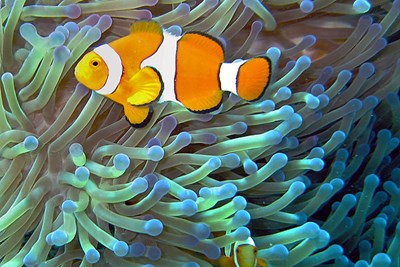Asst. Prof. Nicolai Konow Studies Fish, Bats and Axolotls
 Image by Stock
Image by Stock
09/12/2017
By Katharine Webster
You are what you eat.
That’s a maxim that biologist Nicolai Konow has taken to heart as he studies how butterflyfish survive and thrive by eating coral reefs. He examines everything “from food to poop” to understand the ecological role of the butterflyfish family — and what could happen to the fish in the event of massive coral die-offs.
“They don’t just feed on coral, but each butterflyfish species often eats just one species of coral,” says Konow, an assistant professor of biology. “They’re potentially ill-fated in light of the degradation of coral reefs due to global warming.”
In a recent study, published in the Proceedings of the Royal Society B, he looked at a group of butterflyfish species that evolved a second jaw joint. That second joint allows them to bite off coral polyps, the soft part of the organisms that mass together to form reefs. The study found that the different butterflyfish species all have basically the same jaw shape and length, so it might appear at first blush that they haven’t evolved or differentiated much since they developed the second jaw joint about 5 million years ago.
“Their colors are different, but they all have the same knife and fork,” he says.
 Image by K. Webster
Image by K. Webster
“If you don’t look at the whole functional system, you may be missing important parts of the story,” he says. “The more closely you look, the more you find.”
Konow doesn’t limit himself to fish. He takes X-ray videos of bats and birds in flight to investigate how they take off, hover and land. Students in his lab work on the biomechanics of rats at full gallop and fish gulping their prey.
Konow also studies axolotls (pronounced “ax-uh-lot-uhls”), or Mexican salamanders, which spend their lives underwater but have rudimentary lungs and feet. Many researchers have studied axolotls because they represent an evolutionary link between fish and the first creatures that crawled onto land. But Konow is most interested in what axolotls can tell him about the evolution of tongues, jaws and guts that allowed animals to become permanent land-dwellers eating land-based foods.
“The tongue acts like a piston in water: You pull it back to create suction, and as water flows in, so does your food,” Konow says. “But suction feeding doesn’t work on land. On land, we use the tongue to push and pull the food directly.”
 Image by K. Webster
Image by K. Webster
Konow, who arrived at UMass Lowell a year ago, is affiliated with the newly formed UMass Movement Research Center (UMOVE), a collaboration among chemists, biologists, clinicians, public health experts, nutrition scientists and physical therapists at UML, UMass Amherst and UMass Medical School. The center, led by Assoc. Prof. of ChemistryMatthew Gage, is studying the biomechanics of aging – how bone, muscle and tendon systems work under different conditions and as we age. UMOVE was launched with a $25,000 grant from the UMass President’s Science & Technology Initiatives Fund earlier this year.
Konow says he and Gage, with Asst. Prof. Kelsey Mangano in the Biomedical and Nutritional Sciences Department, just got a seed grant to look at the effects on muscles of resveratrol, a substance found in red grapes that shows some promise in building muscle and slowing the effects of aging.
“Together, we can test muscles, analyze protein chemistry and do genetic screens, and that all becomes a library of how muscles might remodel and change function based on diet,” Konow says. “And the center includes people who can take our research from benchtop to bedside.”




